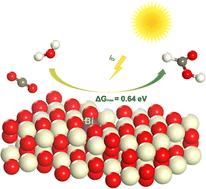当前位置:
X-MOL 学术
›
Sustain. Energy Fuels
›
论文详情
Our official English website, www.x-mol.net, welcomes your feedback! (Note: you will need to create a separate account there.)
Improved photocatalytic carbon dioxide reduction over Bi-doped CeO2 by strain engineering
Sustainable Energy & Fuels ( IF 5.6 ) Pub Date : 2024-02-27 , DOI: 10.1039/d3se01680c Ang Tian 1 , Ziyu Mei 2 , Luyuan Wang 2 , Guangliang Liu 3 , Zhiguo Liu 4 , Guangming Kong 4 , Wenjun Tang 5 , Chuangwei Liu 2
Sustainable Energy & Fuels ( IF 5.6 ) Pub Date : 2024-02-27 , DOI: 10.1039/d3se01680c Ang Tian 1 , Ziyu Mei 2 , Luyuan Wang 2 , Guangliang Liu 3 , Zhiguo Liu 4 , Guangming Kong 4 , Wenjun Tang 5 , Chuangwei Liu 2
Affiliation

|
Room-temperature photocatalytic carbon dioxide reduction reaction (CRR) is an essential method for reducing carbon footprint and achieving valuable fuels. The key challenge to accelerating the process is enhancing the catalytic rate and product selectivity. Herein, we investigate the conversion of carbon dioxide to formic acid on Bi-doped CeO2 in the presence of tensile and compressive strain by using density functional theory corrected for on-site coulombic interactions. As demonstrated, the dopant atom not only benefits the oxygen vacancy formed, but also transfers some electrons to the Ti3+ site, which is the main catalytic site for the CRR. The promising model has excellent product selectivity, offering the best catalytic performance for formic acid (ΔGmax = 0.64 eV). Moreover, the catalytic performance is further improved by the compressive strain. The work provides novel insights into designing environment-friendly and low-cost CeO2-based photocatalysts for carbon reduction.
中文翻译:

通过应变工程改进 Bi 掺杂 CeO2 的光催化二氧化碳还原
室温光催化二氧化碳还原反应(CRR)是减少碳足迹和获得有价值燃料的重要方法。加速该过程的关键挑战是提高催化速率和产物选择性。在此,我们通过使用校正现场库仑相互作用的密度泛函理论,研究了在拉伸和压缩应变存在下, Bi 掺杂的 CeO 2上二氧化碳向甲酸的转化。正如所证明的,掺杂剂原子不仅有利于形成氧空位,而且还将一些电子转移到Ti 3+位点,这是CRR的主要催化位点。该模型具有出色的产物选择性,为甲酸提供最佳的催化性能(Δ G max = 0.64 eV)。此外,压缩应变进一步提高了催化性能。这项工作为设计环保且低成本的CeO 2基碳减排光催化剂提供了新颖的见解。
更新日期:2024-03-01
中文翻译:

通过应变工程改进 Bi 掺杂 CeO2 的光催化二氧化碳还原
室温光催化二氧化碳还原反应(CRR)是减少碳足迹和获得有价值燃料的重要方法。加速该过程的关键挑战是提高催化速率和产物选择性。在此,我们通过使用校正现场库仑相互作用的密度泛函理论,研究了在拉伸和压缩应变存在下, Bi 掺杂的 CeO 2上二氧化碳向甲酸的转化。正如所证明的,掺杂剂原子不仅有利于形成氧空位,而且还将一些电子转移到Ti 3+位点,这是CRR的主要催化位点。该模型具有出色的产物选择性,为甲酸提供最佳的催化性能(Δ G max = 0.64 eV)。此外,压缩应变进一步提高了催化性能。这项工作为设计环保且低成本的CeO 2基碳减排光催化剂提供了新颖的见解。



























 京公网安备 11010802027423号
京公网安备 11010802027423号